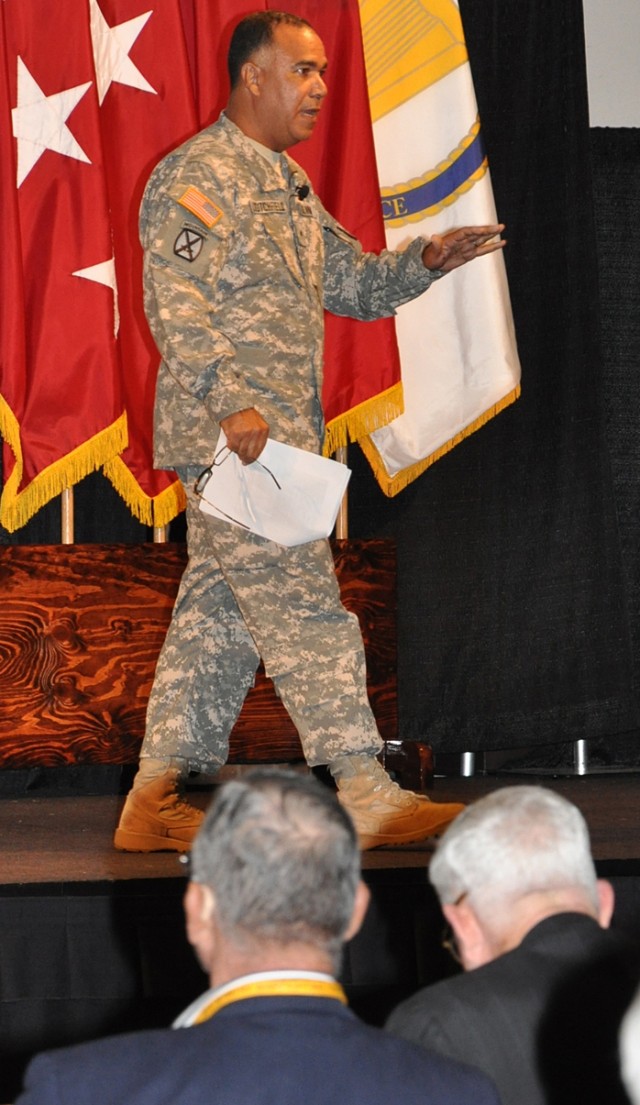COLUMBUS, Ga. - Speaking to more than 1,500 Soldiers, civilians and industry representatives Sept. 14 during the 2010 Infantry Warfighting Conference in Columbus, Ga., Brig. Gen. Anthony G. Crutchfield, U.S. Army Aviation Center of Excellence and Fort Rucker commanding general, addressed the issue of the Aviation school's flight training backlog and what his command is doing to fix the problem.
"We have a backlog of training Aviators," Crutchfield said, "It's taking sometimes 18 months to two years to get through flight school. That's (unsatisfactory)."
Since assuming command of USAACE, Crutchfield, as the Aviation Branch chief, has made eliminating the current backlog his highest priority and recently established a "Backlog Tiger Team" to examine the challenges of training more students faster and find viable solutions to eliminate any future delays to training.
The backlog situation is not new at the school house - with more than 1,250 students in various flight training classes, with more starting every two weeks - the flow is subject to various forces that generate leads and lags in the process. Students routinely experience delays when they move from initial entry rotary wing to advance aircraft qualification training in the UH-60 Black Hawk, CH-47 Chinook, OH-58D Kiowa or AH-64 Apache aircraft. As of Sep. 24, there were 198 flight students waiting to start advanced aircraft qualifications.
"The delays are due to various seen and unforeseen reasons," said Col. Todd Conyers, USAACE G3 operations officer. "Aircraft availability based on maintenance, numbers of training aircraft at Fort Rucker, weather, instructor pilot availability, classroom scheduling and even student availability - to name a few - have impacted or still impact the flow of students through the pipeline. The good news is we're seeing very positive results based on solutions we began applying more than a year ago."
Since 2008, USAACE has reduced the backlog by 46 percent and has estimated it will be eliminated by October 2011. To do so, the command has taken some extraordinary measures.
"We increased our instructor pilots by nearly 40 and reallocated 24 Apaches and 21 Black Hawks pilots to Fort Rucker over the past year," Conyers said. "We also committed more than $92 million in maintenance facility and classroom construction, and are in the process of incorporating the Aviation resource training system across the center of excellence to help us better manage our training resources."
Additionally, under the contingency operation for active duty operational support, 32 instructor pilots with the Army National Guard from across 20 states have volunteered to come to Fort Rucker to serve as instructor pilots.
To support air traffic control operations for the increase in flight training, 19 ATC specialists, mobilized under the same CO-ADOS program, were assigned to Fort Rucker this past year.
According to Crutchfield, while October 2011 remains the target date to have the current backlog eliminated, his command is working to eliminate it earlier.
"As my intent states - 'Nothing is more important than how we train and sustain the flow of highly qualified Aviation professionals to rapidly meet the demands of commanders worldwide,'" he said. "Right now we have to put emphasis on being rapid, because if we can't deliver when needed, we're at risk of becoming irrelevant."


Social Sharing